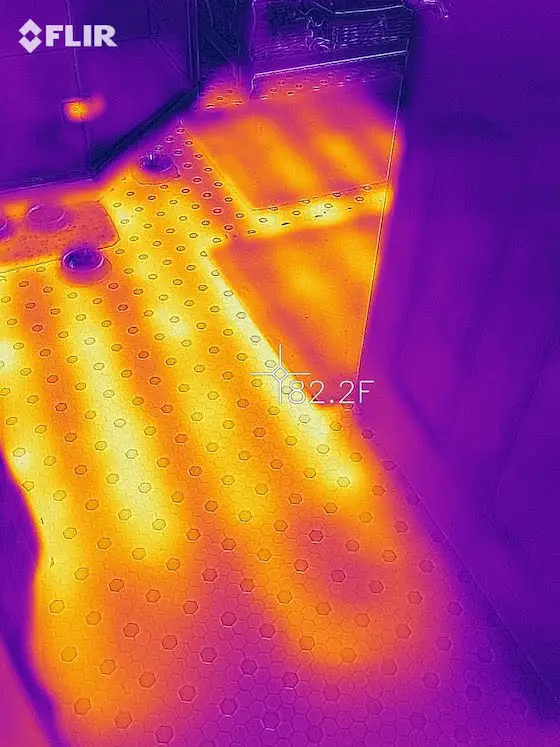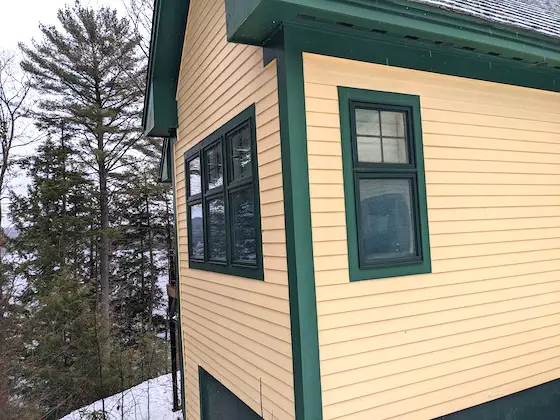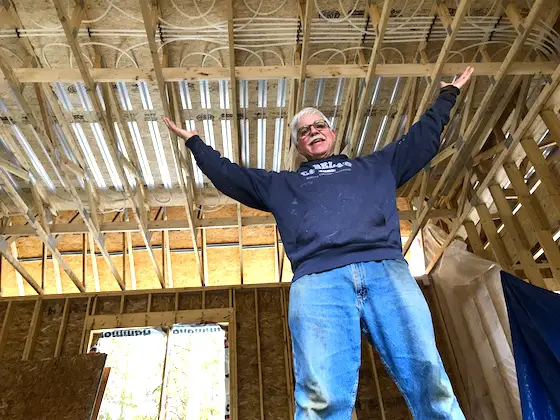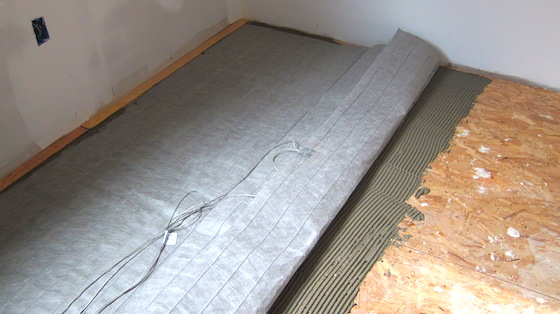How to Make a Roman Hypocaust Warm Floor

How to Make a Modern Hypocaust - This is an infrared photo showing the Uponor heat transfer plates and the Uponor hePEX tubing that keeps my feet toasty warm! Copyright 2023 Tim Carter ALL RIGHTS RESERVED
How to Make Your Bathroom Floor Warm as a Hypocaust
You may find this hard to believe, but I didn’t build the house I currently live in. It’s a long story but this current house in central New Hampshire was supposed to be a transition home while I did build a Queen Anne Victorian house for my family. Those plans were dashed by the horrible economic storm that affected millions in the autumn of 2008. It’s hard to believe that was fifteen years ago!
The builder who constructed my home took any number of shortcuts. I realize many of these may have been directed by the owner who could have been too cheap to invest in certain things. I do know the original owner and his wife only used it during the warmer summer months. That explains why each winter when my wife and I walk on our bathroom floor it feels like we were stepping onto the Athabasca Glacier.
New Hampshire winters can be brutal. The temperature can regularly dip to the single digits at night and never climb above 32 F for days at a time. Add to this a master bathroom that’s on the north end of the house with lots of windows and you have all the ingredients to create an extreme arctic-weather training simulator.

Just behind these two walls you'll discover my master bathroom. There's another window just around the corner making five windows in this tiny 10x10-foot room that faces north. Copyright 2023 Tim Carter
Remodeling Creates Opportunity
Several years ago I remodeled a basement bathroom part of which was under the master bathroom. Fortunately, the walk-out basement of my home has tall 11-foot 6-inch ceilings. I took advantage of this and created a lower ceiling over the basement shower and an adjacent closet. I now had easy access to the floor under the main part of the master bathroom.
My house has radiant hot-water heat and the current master bathroom only had two smaller wall-mounted radiators. These were not sized correctly and the bathroom would be icy cold on bitter days and nights. It would have taken the builder just three extra hours to install aluminum heat transfer plates under the wood subfloor in the bathroom. PEX radiant heating tubing could have been snapped into the transfer plates in less than 30 minutes. It’s not like radiant floor heating is a radically new concept. The Romans developed the hypocaust method of heating floors and walls thousands of years ago.
Aluminum Radiant Heat Transfer Plates
I ended up adding the heat transfer plates but it was a more involved project laying on my back in a cramped space above the basement bathroom. All the while I was mumbling about the lack of foresight of the original homeowner. Anyone who’s walked on a tile bathroom floor, even in a warmer climate, can tell you they’re always cold to the touch.

Above me are quite a few aluminum heat transfer plates and PEX radiant heating tubing. I installed this in my daughter's new home to heat a future Dad apartment over her garage. See the Uponor hePEX tubing in the Uponor radiant heat transfer plates? No wonder I'm so happy! Copyright 2023 Tim Carter
Once I completed the job the floor was instantly warm. I used an infrared thermal-imaging camera to capture the delicious warm heat transfer plates glowing in the photo.
You can create your own warm bathroom floor using hot water from a small water heater. You don’t need a big boiler as I have one that heats my entire home. A simple pump that’s connected to a thermostat sends hot water flowing through the tubing. You can even set up the pump to turn on and off with a timer or smart thermostat. This way you keep energy usage to a minimum.
Electric Fake Hypocaust Floor Heating
You can also create a heated bathroom floor using a thin fiberglass mat that contains heating coils powered by electricity. These mats can be custom-made to fit your exact bathroom size. They can be made to only heat those portions of the floor you walk on saving you as much energy as possible.

This is the electric radiant floor mat that's heating my man cave ham radio shack. It's a great DIY project. CLICK HERE or the IMAGE NOW to order your own NuHeat Electric Floor Heat Mat.
I installed a mat just like this to heat a small man cave I created for myself above my garage. The mat manufacturer works with you asking you how much heat you need so the mat provides the exact amount of comfort you require. In the case of my man cave, the mat had to create all the heat for the space. WATCH THE DIY VIDEOS BELOW.
If you’re remodeling a bathroom that already has a heat vent coming into it or an existing wall radiator, your mat will not need as much heating capacity to just make the floor warm. The mat is connected to a digital programmable thermostat or an app on your smartphone allowing you to easily control the temperature.
Installing the mat is not difficult. Most require that you embed the mat in a layer of cement thinset that you’d use to set ceramic tile. The manufacturer has step-by-step videos showing you how to do this. Once the thinset has dried, you then just cover the mat with a thin 1/4-inch layer of thinset.
Tile or laminate flooring can be installed directly on top of this second layer of the thinset. This layer of thinset acts as a heat sink and helps to ensure the temperature of the floor is distributed evenly so no matter where your bare foot steps, the floor is toasty warm. You can make it so warm that you may want to sleep on the floor in a sleeping bag!
Column 1496